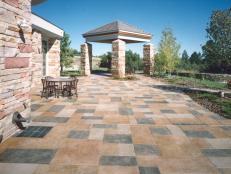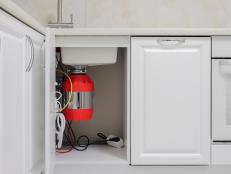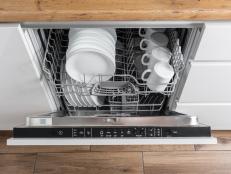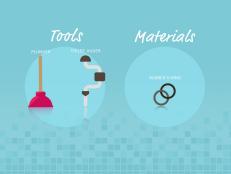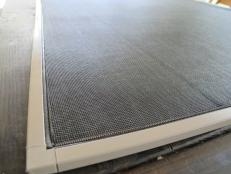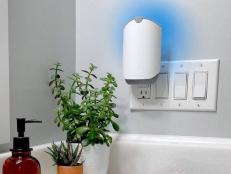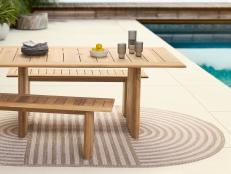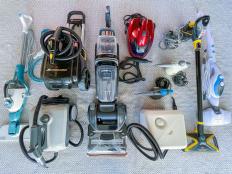16 Deck and Patio Ailments (and How to Fix Them)
When something goes wrong with your deck or patio, should you attempt a DIY fix or call a pro? We’ll help you diagnose your deck and patio disorders and determine the best remedy.

Solena Landscape Co.
If you’re starting to see signs of wear and tear — or outright trouble — on your deck or patio, what should your next step be? As a general guideline, says Mitch Kalamian, owner of Solena Landscape Co., cosmetic damage can be a DIY fix, but structural damage generally requires the advice and skills of a professional to correct. “If you start with construction done properly in the first place, you’re a lot less likely to have issues,” he says. “But if that isn’t the case, paying for professional expertise is always advisable.”
Here’s our advice for some common problems you may experience, starting with hardscaping:
Stone and Concrete Patios
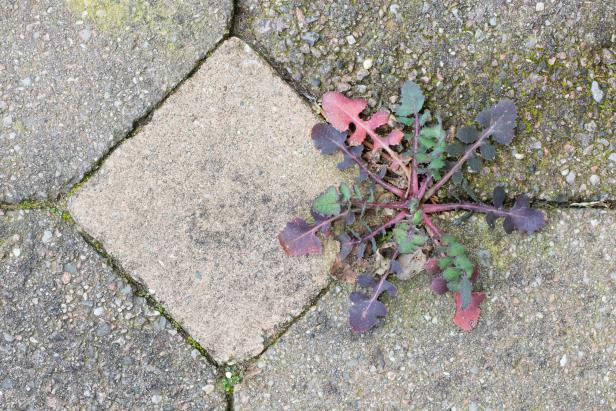
©iStockphoto.com/MyImages_Micha
Dirty or moldy surface. This is one fix you can perform yourself, and it may be as simple as a scrub with mild detergent. But if you have a stubborn mold problem — say, if your patio receives mostly shade — Kalamian recommends pressure washing first, then getting down on your hands and knees to sponge the surface with a very dilute mixture of muriatic acid and water. (Muriatic acid is available at hardware stores or pool supply stores; be sure to wear gloves and safety glasses as you work.) A final pressure wash when you’re done should leave you with a bright, clean surface.
Broken, uneven or sunken pavers. In general, call a pro. Man-made pavers are typically installed on a base of gravel and sand, and although it’s fairly easy for a professional to reinstall that base to correct undulation, Kalamian says, it’s much less so for a homeowner unless you’re experienced. Got just a single broken paver you’d like to replace or want to tackle the whole job yourself?
Weeds in joints. Fix it yourself. “Keep a handle on weeds because once they get out of control, it becomes a big job,” Kalamian says. Keep your patio swept free of dirt buildup that can harbor seeds, and pull any weeds you see immediately. A caveat: if the same weeds keep coming back, resist the urge to pull and use a glyphosate herbicidal spray instead, which kills the roots via contact with the leaves. After the weed is nice and brown, then you’re cleared to pull it up. Also, consider replacing plain sand joints with polymeric sand, which hardens into a cement-like mix where weeds can’t grow.
Hairline cracks in concrete. Leave it alone. “A hairline crack is acceptable by industry standards — it’s an aesthetic problem only,” Kalamian says. “It’s a really tough thing to fix. You could put grout or cement in the crack yourself, but it won’t look great.” Plus, there’s a reason the concrete was stressed in that spot in the first place, so any fix you attempt probably won’t last.
Heaved concrete. Call a pro. “Concrete shouldn’t heave,” Kalamian says. “If your patio is heaving, there’s definitely an issue, and removing it is the only option.” Although it’s technically possible to replace a small section that has been damaged, it won’t match the old section, and you won’t resolve the underlying problem.
Brick mortar popping out. Fix it yourself, but know it might be a temporary solution. Brick is typically laid on a base of concrete, and broken or missing mortar may indicate that the base is compromised and needs to be redone. If you elect to repair it yourself, be sure to clean the patio thoroughly first so that you can accurately match sand colors for your new batch of mortar.
Lime or mineral deposits. Fix them yourself. Concrete is porous and can be prone to staining (say, from minerals deposited when you water potted plants) but also frequently releases a whitish film known as efflorescence that comes from water trapped inside. To clean, power wash or use the same muriatic acid solution described above; don’t use bleach or commercial lime cleaners, which aren’t intended for concrete surfaces. If you want to prevent efflorescence from recurring, “you need to reseal every two years like clockwork,” Kalamian says.
Grease stains. Fix them yourself. Kalamian recommends using a standard over-the-counter grease remover from your local hardware store — but know that if you’ve allowed a stain to sit too long, it’s probably not coming out.
Wooden Decks

©iStockphoto.com/tab1962
Peeling or faded sealant. Fix it yourself, and do it promptly (every two years is a good rule of thumb) so that all the wood is evenly protected. Get step-by-step instructions on this project here.
Moss and lichen growth. Fix it yourself, via power washing, to avoid slippery walking surfaces, but be careful not to use too much pressure. (If you aren’t sure of what you’re doing and don’t want to risk damaging your deck, it’s perfectly acceptable to call a pro for this job.) Overzealous power washing can scratch up the surface of the wood, inviting even more growth over time.
Missing, warped or cracked boards. Fix these yourself, as long as the problem is small. “If you can isolate the problem, you can solve it,” Kalamian says — meaning, if you can add a new fastener or two, or replace some damaged boards, and the deck is good to go with no leaning or swaying, you’re good. But if small fixes don’t eliminate movement, get a contractor to take a look.
Spongy decking underfoot. Call a pro. If the problem is widespread enough that it can’t be corrected by replacing a few boards, you’re looking at a real safety hazard that requires professional attention.
Swaying or leaning. Ditto. “Unless your deck is six inches off the ground, there are very few instances where you should tackle this on your own,” Kalamian says. Even if the problem can be fixed — by installing angle bracing, for example — you need a professional to determine whether repair or replacement is in order.
Wobbly, undersized or rotten posts. Call a pro. If your posts are an isolated problem and the deck is in otherwise good shape, you may be able to repair the posts rather than replace the entire deck, but shoring up the deck properly so it doesn’t collapse while you’re working requires experience.
Rotting or missing ledgerboard. Get professional help for any problems with the deck’s point of attachment to the house, which is critical to its stability. “There are endless issues involving the ledgerboard — bolts rusting through, insufficient bolting, moisture — but a homeowner doesn’t necessarily know what to look for,” Kalamian says. “Sometimes it should be dismantled, or sometimes you can simply replace it or bolt it properly, but that’s a pro’s call.”
Wobbly railing or stairs. If your handrails or steps wobble or lean under pressure, consult a professional ASAP, even if you think the problem looks simple to fix. It’s a safety issue that must be handled according to building codes.











